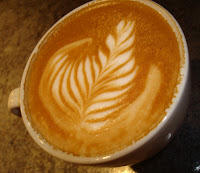Don’t Fear Your Barista! When you walk into a coffee shop do you stand and look at the menu for five minutes only to decide on a drip coffee? Are you afraid you won’t like what you have ordered but too embarrassed to ask the barista, “What is a latte?” Well, don’t be afraid! Ask! Coffee shop owners and baristas (Italian for bartender) love to educate their customers. They want you to feel comfortable and have the knowledge and confidence to want to walk through the door.
Here is a quick lesson to get you started:
Here is a quick lesson to get you started:
1) Regular drip coffee is far from regular. Specialty coffee shops serve high quality coffee made with Arabica beans, and when prepared with the right equipment; produce an excellent cup of coffee. You may encounter several “drip” choices. Much like wine, coffee beans take on different flavors depending on the soil and climate in which the coffee plant was grown. Single origin coffee is made from beans that have not been blended with coffee beans from other regions (or even other farms) and blends are single origins craftfully blended together. The taste preference; however, is personal. Keep in mind that a dark roast will actually have a little less caffeine than a lighter roast (yes, this is deceiving). So if you want a pick-me-up, order the light roast.
2) Espresso (not eXpresso, this is a common error) is a method of preparing coffee using an espresso machine; specifically, the espresso machine forces hot water through finely ground, dark roasted coffee beans; resulting in Italian style coffee. One “shot” of espresso is equal to about one ounce of a strong, rich, smooth coffee.
3) Americano is espresso with hot water added to create an American style cup of coffee.
4) Cappuccino is made with 1/3 espresso, 1/3 velvety smooth milk, and 1/3 milk foam. It is generally served in a small sized cup. It feels light, because the foam takes up the volume, and it is not sweetened unless you request flavors or sweeteners. If you like a little more milk, you can request a wet cappuccino, or if you like a little less milk, order a dry cappuccino.
5) Latté in Italian means milk. Here in the
6) A Macchiato (mock-e-AH-toe) is really an Italian term meaning spotted with a little milk. The drink Macchiato is classically prepared as an espresso topped with a small amount of milk foam. This drink is often Americanized or modified in many coffee shops, so be sure to ask before you order. A caramel macchiato is generally prepared with a small amount of vanilla syrup, velvety smooth milk foam, espresso poured over top, and then topped with a ribbon of caramel sauce. This drink would not be served in a large cup unless you have requested extra milk, but adding milk pretty much makes this drink a latté.
The drink size will determine how many espresso shots are in drink, but this varies at each shop so be sure to ask. If you enjoy a stronger coffee flavor you can order more “shots” of espresso. If you like your drinks sweetened or flavored, you can request additional flavor or sweetener in any drink (even your drip coffee). Don’t be intimidated; order what sounds good to you. Most shops enjoy catering to special requests.
Once you are comfortable with the terminology, you can order a customized drink to fit your mood. And once you experience a really good espresso or latté, you will understand why coffee shops have become so addicting!
The drink size will determine how many espresso shots are in drink, but this varies at each shop so be sure to ask. If you enjoy a stronger coffee flavor you can order more “shots” of espresso. If you like your drinks sweetened or flavored, you can request additional flavor or sweetener in any drink (even your drip coffee). Don’t be intimidated; order what sounds good to you. Most shops enjoy catering to special requests.
Once you are comfortable with the terminology, you can order a customized drink to fit your mood. And once you experience a really good espresso or latté, you will understand why coffee shops have become so addicting!

No comments:
Post a Comment